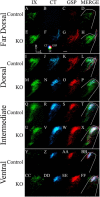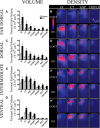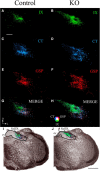Selective Deletion of Sodium Salt Taste during Development Leads to Expanded Terminal Fields of Gustatory Nerves in the Adult Mouse Nucleus of the Solitary Tract
- PMID: 28100747
- PMCID: PMC5242412
- DOI: 10.1523/JNEUROSCI.2913-16.2016
Selective Deletion of Sodium Salt Taste during Development Leads to Expanded Terminal Fields of Gustatory Nerves in the Adult Mouse Nucleus of the Solitary Tract
Abstract
Neuronal activity plays a key role in the development of sensory circuits in the mammalian brain. In the gustatory system, experimental manipulations now exist, through genetic manipulations of specific taste transduction processes, to examine how specific taste qualities (i.e., basic tastes) impact the functional and structural development of gustatory circuits. Here, we used a mouse knock-out model in which the transduction component used to discriminate sodium salts from other taste stimuli was deleted in taste bud cells throughout development. We used this model to test the hypothesis that the lack of activity elicited by sodium salt taste impacts the terminal field organization of nerves that carry taste information from taste buds to the nucleus of the solitary tract (NST) in the medulla. The glossopharyngeal, chorda tympani, and greater superficial petrosal nerves were labeled to examine their terminal fields in adult control mice and in adult mice in which the α-subunit of the epithelial sodium channel was conditionally deleted in taste buds (αENaC knockout). The terminal fields of all three nerves in the NST were up to 2.7 times greater in αENaC knock-out mice compared with the respective field volumes in control mice. The shapes of the fields were similar between the two groups; however, the density and spread of labels were greater in αENaC knock-out mice. Overall, our results show that disruption of the afferent taste signal to sodium salts disrupts the normal age-dependent "pruning" of all terminal fields, which could lead to alterations in sensory coding and taste-related behaviors.
Significance statement: Neural activity plays a major role in the development of sensory circuits in the mammalian brain. To date, there has been no direct test of whether taste-elicited neural activity has a role in shaping central gustatory circuits. However, recently developed genetic tools now allow an assessment of how specific taste stimuli, in this case sodium salt taste, play a role in the maturation of the terminal fields in the mouse brainstem. We found that the specific deletion of sodium salt taste during development produced terminal fields in adults that were dramatically larger than in control mice, demonstrating for the first time that sodium salt taste-elicited activity is necessary for the normal maturation of gustatory inputs into the brain.
Keywords: ENaC; activity; axons; epithelial sodium channel; knock out; medulla.
Copyright © 2017 the authors 0270-6474/17/370660-13$15.00/0.
Figures







Similar articles
-
Maintenance of Mouse Gustatory Terminal Field Organization Is Disrupted following Selective Removal of Peripheral Sodium Salt Taste Activity at Adulthood.J Neurosci. 2017 Aug 9;37(32):7619-7630. doi: 10.1523/JNEUROSCI.3838-16.2017. Epub 2017 Jul 4. J Neurosci. 2017. PMID: 28676575 Free PMC article.
-
Selective Removal of Sodium Salt Taste Disrupts the Maintenance of Dendritic Architecture of Gustatory Relay Neurons in the Mouse Nucleus of the Solitary Tract.eNeuro. 2020 Oct 28;7(5):ENEURO.0140-20.2020. doi: 10.1523/ENEURO.0140-20.2020. Print 2020 Sep/Oct. eNeuro. 2020. PMID: 32817119 Free PMC article.
-
Chorda tympani nerve terminal field maturation and maintenance is severely altered following changes to gustatory nerve input to the nucleus of the solitary tract.J Neurosci. 2011 May 25;31(21):7591-603. doi: 10.1523/JNEUROSCI.0151-11.2011. J Neurosci. 2011. PMID: 21613473 Free PMC article.
-
[Progress in the effects of injury and regeneration of gustatory nerves on the taste functions in animals].Sheng Li Xue Bao. 2014 Oct 25;66(5):519-27. Sheng Li Xue Bao. 2014. PMID: 25331997 Review. Chinese.
-
The gustatory system of lampreys.Brain Behav Evol. 2010;75(4):241-50. doi: 10.1159/000315151. Epub 2010 Jul 24. Brain Behav Evol. 2010. PMID: 20664239 Review.
Cited by
-
Maintenance of Mouse Gustatory Terminal Field Organization Is Disrupted following Selective Removal of Peripheral Sodium Salt Taste Activity at Adulthood.J Neurosci. 2017 Aug 9;37(32):7619-7630. doi: 10.1523/JNEUROSCI.3838-16.2017. Epub 2017 Jul 4. J Neurosci. 2017. PMID: 28676575 Free PMC article.
-
Selective Removal of Sodium Salt Taste Disrupts the Maintenance of Dendritic Architecture of Gustatory Relay Neurons in the Mouse Nucleus of the Solitary Tract.eNeuro. 2020 Oct 28;7(5):ENEURO.0140-20.2020. doi: 10.1523/ENEURO.0140-20.2020. Print 2020 Sep/Oct. eNeuro. 2020. PMID: 32817119 Free PMC article.
-
Ubiquitin Ligases Involved in the Regulation of Wnt, TGF-β, and Notch Signaling Pathways and Their Roles in Mouse Development and Homeostasis.Genes (Basel). 2019 Oct 16;10(10):815. doi: 10.3390/genes10100815. Genes (Basel). 2019. PMID: 31623112 Free PMC article. Review.
-
Regenerative Failure Following Rat Neonatal Chorda Tympani Transection is Associated with Geniculate Ganglion Cell Loss and Terminal Field Plasticity in the Nucleus of the Solitary Tract.Neuroscience. 2019 Mar 15;402:66-77. doi: 10.1016/j.neuroscience.2019.01.011. Epub 2019 Jan 24. Neuroscience. 2019. PMID: 30684590 Free PMC article.
-
The transcription factor Phox2b distinguishes between oral and non-oral sensory neurons in the geniculate ganglion.J Comp Neurol. 2017 Dec 15;525(18):3935-3950. doi: 10.1002/cne.24312. Epub 2017 Sep 15. J Comp Neurol. 2017. PMID: 28856690 Free PMC article.
References
Publication types
MeSH terms
Substances
Grants and funding
LinkOut - more resources
Full Text Sources
Other Literature Sources
Medical
Molecular Biology Databases
